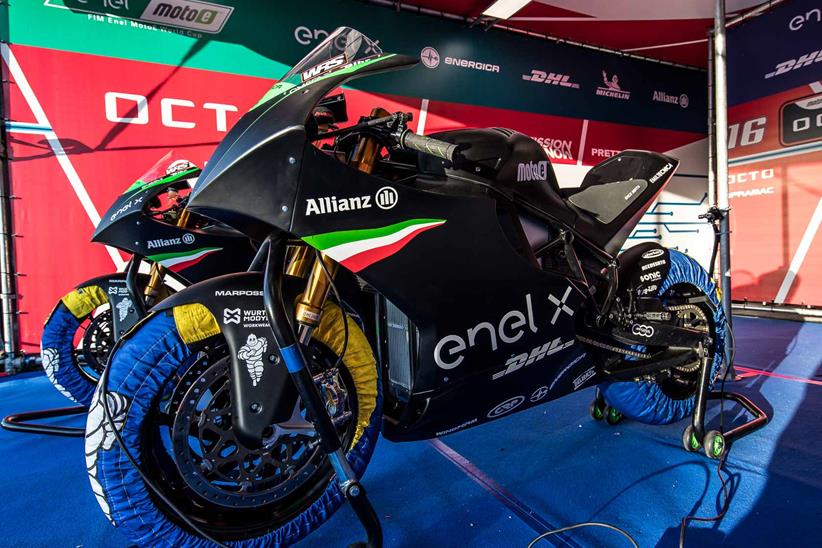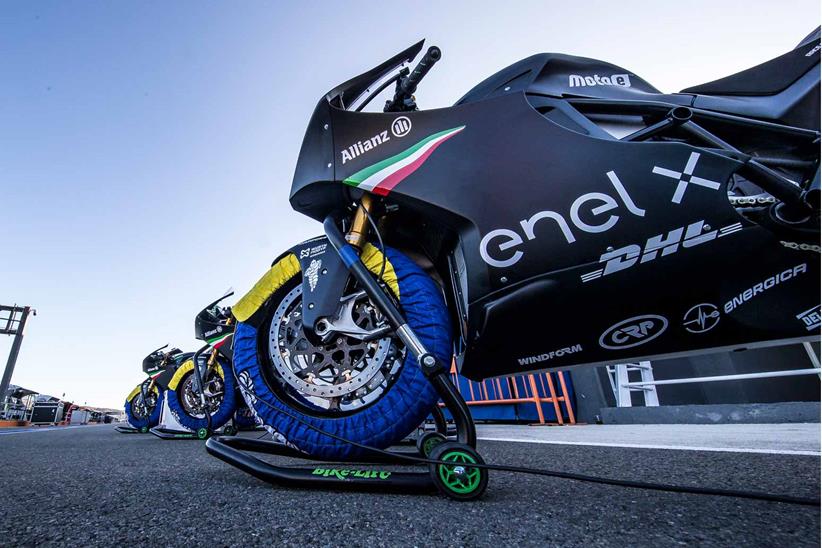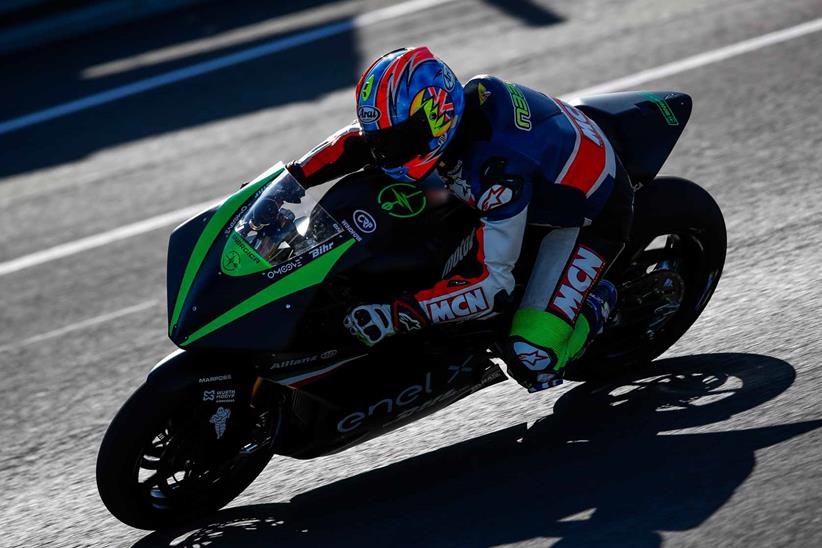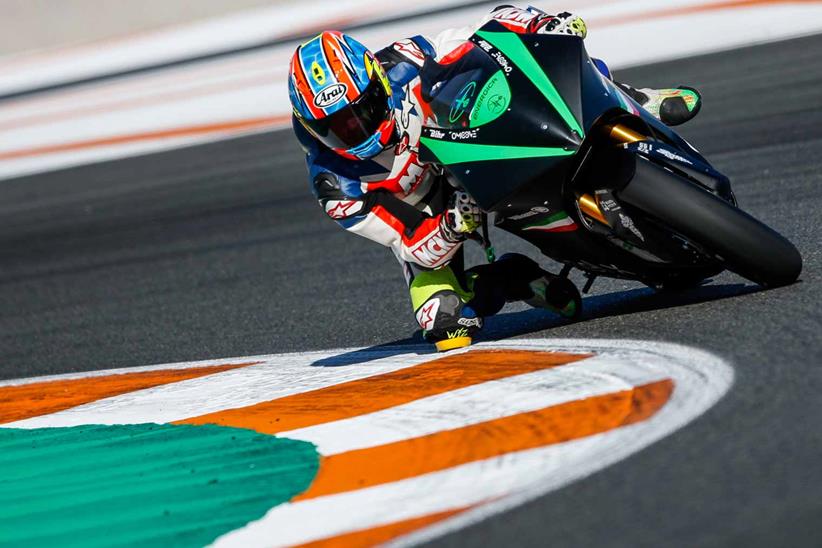Riding a MotoE-spec Energica Ego Corsa electric motorbike at Valencia
Most people think battery motorcycles are heavy, slow, boring and lack soul. As for electric racing bikes – well they’re just plain dull, aren’t they?
Well, after riding Energica’s MotoE racer at Valencia the day after the final MotoGP of 2019, I’m here to tell you it’s sensational. Surprised? I was, but it isn’t as daft sounding as you’d imagine.
First-off, the Ego Corsa runs top notch Öhlins, set up by some of the best racers and teams in the world, who know exactly how a bike should handle. It has the best-of-the-best WSB spec Brembos (used by MotoGP in the wet) and the stickiest, soft compound Michelin MotoGP tyres you, me or Rossi will ever get to enjoy.
Chassis-wise, those three things alone put the MotoE racer at a higher level than any built-to-a-price road-going superbike you can buy – V4Rs and S1000RRs included. The Energica’s party piece is its corner entry speed – absolutely insane.
![]()
Yes the 258kg Ego Corsa is heavy if you’ve come from a pure racing background, but it isn’t over the top from a road rider’s perspective, especially when you’ve got calipers with this much power and an extra little button on the left switchgear to give you a dash more engine braking when you need it.
It’s not slow, either. Pumping out 160bhp-ish from its electric motor it’ll hit 170mph at the end of a long straight and deliver the kind of acceleration that, in the hands of a racer, will smoke its sticky rear Michelin on demand. Best of all its smooth power delivery from zero to 6000rpm and delightful throttle response would make even the best sorted piston engines weep into their unleaded.
Valencia is a bugger of a stop/start track littered with decreasing radius corners. Back-shifting, braking and turning is a pain on a normal bike around here, but with no clutch or gears to worry about the, track suddenly flows beautifully.
It’s not as if you miss the sound of an engine, either, because hurtling around a track on most bikes the noise in your ears is from the wind. The MotoE is slightly quieter on a fast lap and the racket inside my Arai isn’t massively different to a ‘real’ bike.
MotoE racers churn out lap times that even the most seasoned of fast group trackday riders and club racers couldn’t match on a slick shod, road-going superbike and now it’s easy to see how. I never thought I’d love riding an electric bike around a circuit quite so much and after my allotted seven laps are over, I’m left wanting more. I’m surprised I haven’t even missed the engine noise, vibration, gears or clutch.
If there was an Energica Ego Corsa and a road going S1000RR sat in the pitlane that day I’d have choosen the MotoE every time, mostly because of its incredible chassis, but also because the motor makes it easier to ride flat out. Of course, fit top level suspension, tyres and brakes to the BMW and it would leap ahead…
I never thought I’d say this, but the Ego Corsa has convinced me that if the world turned its petrol taps off tomorrow, life really wouldn’t be so bad.
![]()
Electric racing snippets:
Why? Racing improves the breed. As a result of MotoE, Energica are fitting smaller, more powerful batteries to their 2020 models with 60% more range.
What is MotoE? A single make electric championship supporting MotoGP with all riders using the same machine, based on the Ego sportsbike. Its chassis has lighter tubes, different welding and racier steering geometry to the road bike.
What Energica says? Giampiero Testoni, Energica Technical Director, says: “Riders are very happy. They forget about shifting and the clutch, they just concentrate on the riding and the feeling is they can corner well with lots of traction and grip.
“The bike feels much lighter than it really is, they don’t even notice it other than a little bit under braking. They like the smoothness, the feeling of the throttle, braking is very good. Overall it’s very positive.”
How much juice is left after a race? MotoE races are between five and seven laps, depending on the track. They could go on for longer, but Energica are playing safe to begin with and there isn’t even a warm-up lap. Bikes finish the races with around 35-40% battery left and take around 45 minutes to fast charge in the paddock.
![]()
Electronics? There’s no traction control or ABS – the only rider aid is a button on the left switchgear for extra engine braking if the rider needs it. The colour dash is the same as the road bike’s, but there’s no speed or rev display, just battery and motor information, Dorna telemetry and messages.
Don’t they catch fire? The blaze at the Jerez test at the beginning of the year was disastrous for everyone involved, but it was a fault of a development fast charger and not a bike. Even so, the MotoE paddock is on the fringes of the MotoGP pits and is guarded by two firemen, constantly checking battery temperatures.
How do the marshals pick them up after a crash? With difficulty. During the Valencia race it took eight rubber glove and boot-wearing marshals and a front wheel skid to recover a crashed MotoE from the gravel.
What about the noise? They might scream like a squadron of little jet fighters, but all you can hear is the scraping of knee sliders (and sometimes the screams from injured riders) and on the first lap, the tortured wail and screeching tyres of the V8 BMW safety car. Next year MotoGP will be banned for warming their engines while MotoE is running.
















